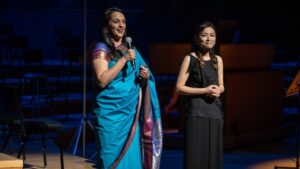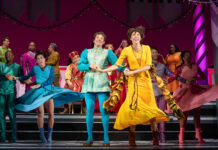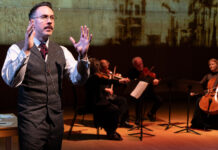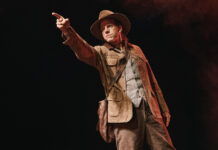“If you create a situation where people have a venue to be able to trust one another, then difficult conversations can happen.” That’s not just what composer Reena Esmail says, but also what she likes to do. Not just amongst the musicians who perform her music, but also amongst the artists and the audience at any given concert.
This Sunday the Los Angeles Master Chorale will give the world premiere of Malhaar: A Requiem for Water at the Walt Disney Concert Hall. It’s a work that combines, as much of her music does, Hindustani and Western classical music styles.
I know what you are thinking, a requiem for water when Los Angeles is getting more rainfall this year than it has in decades. Of course there is an irony to that. But the composition of music doesn’t happen overnight. Any more than one season of rain makes up for multiple years of drought.
Born in Los Angeles, Esmail’s music has been performed Kronos Quartet, the Seattle Symphony (where she was composer-in-residence 2020-2021), Imani Winds, Brooklyn Rider and more. She is currently the Swan Family Artist-in-Residence at the LA Master Chorale where many of her works have been performed.
Earlier this month I spoke with Esmail about Malhaar: A Requiem for Water, finding emotionality in environmental issues and, yes, the irony of finishing the requiem during a deluge of rain. What follows are excerpts from our conversation that have been edited for length and clarity. To see the full interview, please go to our YouTube channel.
In your TEDx Skid Row talk 9 years ago you said, “I’m at the beginning stages of this journey. I might always be at the beginning stages of this journey.” Where do you feel you are today and what step in that journey does Malhaar: A Requiem for Water represent?
I still feel like I’m at the beginning stages of this journey. When I had given that [talk] I had just come back from India and I was trying to figure out how do I bring these two cultures, these two worlds, these two musical languages together? I was asking that question for the first time in many ways. I was really just kind of throwing things at the wall to see what stuck. And I would take a certain element from Indian classical music, a certain element from Western classical music, and try to see what would happen when I put them in dialogue with one another.
It’s almost a decade later and I feel like I’m just asking that question in really new ways. But I think over time what tends to happen is the more you do that, the more you’re almost creating this third space where certain combinations exist and then become kind of fused together in a dialogue that is, I guess, in its own language.
This piece feels like a step in a new direction because it’s one of the first times that I’ve written a piece that involves Indian and Western classical musicians together that isn’t necessarily on the theme of that involvement. I’m trying to move into that space where I’m using these two styles of music to tell a story that is so far beyond just what that connection is between those styles of music.
As you ask that question in new ways are you finding that you are getting different answers now?
I’m in different places because these cultures have people in them, right? They’re not just disembodied cultures. Every time I come into dialogue with new people there are new questions. Since that time, I’ve come into dialogue with some of the most famous Indian artists of our time. I’ve been so privileged to write for and work with them. They bring their own context because they’ve had decades and decades of experience in a particular tradition and some of them have even had experience crossing over. So you can do really interesting and different things.
You posted on Facebook last week that “My 2022 is finally over. This is the last barline of my Requiem – two months and two days late, but mercifully, I am done.” What were the biggest challenges for you in writing Malhaar: A Requiem for Water?

The first biggest challenge was just time because 2022 for me, and I think probably for many composers, was that crazy year where everything that was rescheduled was rescheduled into that year from the past couple of years of COVID. Then everything that was in 2022 didn’t get moved. So basically we were writing three years of music on top of one another. And so that was the 16th of 16 commissions that I wrote in 2022. So you can tell my 2022 ended on March 2nd, 2023.
I think the other musical challenges were I realize I have never written a piece originally for choir and Indian voice at the same time. We all have certain ranges that our voice can sing in. I don’t know why I didn’t quite realize this before, but the fact that the Hindustani tessitura lies about a fifth below the Western female tessitura creates a lot of interesting challenges. What key do you set something and how do you make everyone feel comfortable in their own range?
[Tessitura is Italian for texture and refers to a range of pitches within vocal lines of music]
The other thing that I ran up against, after over a decade of working in this field, I didn’t quite realize that a lot of times I set Indian classical ragas into Western settings and in instrumental music. But I realize that when you’re speaking in English or even in Latin, it’s very hard to set raga in a way that sounds authentic. If you look back through the tradition, you’ll see it’s rarely done. It’s mostly people singing in Indian languages and there is a reason for that.
[In Hindustani music a raga is a pattern of notes with uniquely characteristic intervals, rhythms and embellishments that serve as the foundation for improvisation.]
A malhaar is usually associated with torrential rains. It seems appropriate that you finished this work as Los Angeles was being pelted with torrential rain. Did it strike you as ironic or was that in any way also inspirational for you?
[Malhaar is a raga named after the “giver of rains.”]
Writing this requiem that had to do with water and the disappearance of water is something that goes back to my childhood. It’s not just something that is happening now in context of climate change. But what was really interesting is the minute I started writing in January, I took a month off just to really work on the scaffolding of the requiem. The other thing I was doing was hiking. My hikes would just constantly get canceled because it was raining. Then I’m working on this requiem about the disappearance of water.
It’s funny because if you see it through traditional Indian eyes, malhaars are the ragas that are designed to beckon rain. So you’re singing this raga hoping that rain will come. On the spiritual level I’m thinking am I somehow beckoning the thing that I am trying to write about the disappearance of? It messed with me in all kinds of ways. But at the same time, it is inspiring to me because growing up in LA rain is so special.
Since the onslaught of the pandemic we’ve been surrounded by loss of all kinds. Loss is part of any requiem. We’ve been challenged and continue to be challenged by water supply issues. How do you go about addressing these issues vis-á-vis your music in a way that is both emotional and intellectual?
I think grief and loss and those emotions are things that we experience viscerally. I’m looking at the L.A. Times every day and I’m seeing now water is being lost in this way. Here are the facts, here are the statistics. All of this is very important. But none of those things make you feel like this is actually something that is deeply emotional. I think that we are incentivized to act when we feel that emotional response.
So I thought to myself, what is a way to bring some kind of esthetic around this that is more than just these are the facts. To actually connect into our heart space when we’re thinking about what to do about this water crisis. That was largely why I decided to write this requiem about water. That’s in front of us as people who live in Los Angeles every single day. And yet it’s a thing that we just have to tune out because maybe it feels like it’s too big to deal with or we can’t do anything about it. It’s also a thing that’s really scary, right?

What I wanted to do is actually connect some of those feelings that I know other Angelenos share about how terrifying it is to lose water; how much we maybe need to grieve. All these places we see that are just completely empty that we know used to have water in them. Just the terror of seeing that and the grief of that.
The end of the requiem is essentially making the point water is going on to its next life. Water is not just being destroyed. It will find the place that is the best for it. If we are not making a place that’s conducive to it, it will find somewhere else.
Water is going to be fine. It’s us that are going to be mourning its loss. So what do we do to actually not have to completely mourn the loss and preserve what we have left?
I went back to the first interview that I posted to our YouTube channel because the person I interviewed, a musician, said the following, “Hopefully what any creative endeavor accomplishes is the ability to create a portal, that mirror or lens of one’s attention in time, to be able to give oneself a glimpse to say, you know what, I have the right to create something, too. I have a voice. I have something to say. Whether we’re going to sit ourselves down and apply ourselves to the craft of creating, manifesting something from that capacity is the work before us.” Do you agree and what resonates with you today on your journey as the work before you?
It’s funny because as you were saying that, I was like, I think I know the person who said that. I’ve had many discussions like that in the context of my own home, in fact.
It was your husband, Vijay Gupta, who said that.
This idea of art as a portal, and the fact that that anyone should be able to express themselves through art, I absolutely agree with that. Those were the values that we very much first connected on. In my case I see that there’s this portal that exists between different musical cultures and we think of them as so separate because the surface of them might seem really different.
Say someone’s performing a string orchestra piece of mine that uses Indian classical music. There will be someone who is like, I’m getting kind of a taste of this through my own lens. I’m getting maybe one version of this improvisation kind of frozen for me so that I can actually learn it in my own instrument the same way that you would transcribe a jazz solo or something like that.
But then there will always be those musicians in every group who think, let me go further, let me actually go into Indian classical music itself and vice versa from Hindustani into Western classical music. That is the joy – to see someone actually take the ball and go through that portal and just run with it until they’re on the other side and can make their own connections.
I think about that a lot and how to facilitate those connections between people so that it’s not just me in there all the time. Being that conduit is important and just feels amazing.
To watch the full interview with Reena Esmail, please go here.
Main Photo: Composer Reena Esmail (Photo by Martin-Jamie Pham/Courtesy LA Master Chorale)












